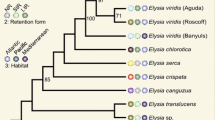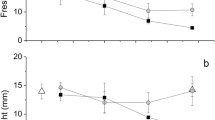Abstract
The sea slug Elysia clarki sequesters photosynthetically functional chloroplasts from at least a dozen algal species and maintains these plastids for up to 4 months. Elysia papillosa and Placida kingstoni also feed on some of the same, or congeneric species such as Bryopsis plumosa and Penicillus lamourouxii, but cannot maintain plastids longer than 2 weeks. Photosystem II maximum quantum efficiency (ϕIIe-max) was measured in freshly fed specimens of E. clarki, E. papillosa, and P. kingstoni using pulse amplitude modulated (PAM) fluorescence. The slugs were then immediately starved, and PAM fluorescence measurements continued with starvation until ϕIIe-max reached near 0 or animals expired. Initially, E. clarki fed either P. lamourouxii or B. plumosa had ϕIIe-max values that were statistically equivalent. However, as length of starvation increased, ϕIIe-max decreased differently. After 12 weeks, E. clarki fed B. plumosa had no ϕIIe-max activity, while those fed P. lamourouxii still had low ϕIIe-max levels. Freshly fed E. papillosa had ϕIIe-max > 0.5 initially, which declined over the next 12 days of starvation. Freshly fed P. kingstoni specimens also had ϕIIe-max > 0.5 immediately, but it rapidly dropped to near 0 over the next 4 h of starvation. Thus, the algal source of sequestered chloroplasts in E. clarki has a minor effect on chloroplast longevity and ϕIIe-max values during prolonged starvation. However, among slug species, specific adaptations account for the tremendous variation in the length and functionality of these kleptoplastic associations.



Similar content being viewed by others
Notes
We have previously reported (Curtis et al. 2010) the identity of Florida specimens of Elysia feeding on Penicillus capitatus as E. patina following the description of Ortea et al. (2005), which has been called to our attention is unfortunately incorrect. Patrick Krug (personal communication), and our own SEM examination (W. Gowacki, personal communication), have found that the radula tooth of our specimens matches that of E. papillosa (Verrill 1901) Marcus 1957, rather than the distinctly different tooth of E. patina Ev. Marcus 1980. Our specimens used here and previously ( Curtis 2010) are E. papillosa and the Ortea et al. (2005) description of E. patina is actually E. papillosa and should not be followed.
References
Akimoto A, Hirano YM, Sakai A, Yusa Y (2014) Relative importance and interactive effects of photosynthesis and food in two solar-powered sea slugs. Mar Biol 161:1095–1102
Burghardt I, Wägele H (2004) A new solar powered species of the genus Phyllodesmium Ehrenberg, 1831 (Mollusca: Nudibranchia: Aeolidoidea) from Indonesia with analysis of its photosynthetic activity and notes on biology. Zootaxa 596:1–18
Burghardt I, Wägele H (2006) Interspecific differences in the efficiency and photosynthetic characteristics of the symbiosis of “solarpowered” Nudibranchia (Mollusca: Gastropoda) with zooxanthellae. Rec West Austr Mus Suppl 69:1–9
Burghardt I, Evertsen J, Johnsen G, Wägele H (2005) Solar powered seaslugs – mutualistic symbiosis of aeolid Nudibranchia (Mollusca, Gastropoda, Opisthobranchia) with Symbiodinium. Symbiosis 38:227–250
Christa G, Zimorski V, Woehle C, Tielens AGM, Wägele H, Martin WF, Gould SB (2014a) Plastid-bearing sea slugs fix CO2 in the light but do not require photosynthesis to survive. Proc R Soc B 281:20132493
Christa G, Händeler K, Kück P, Vleugels M, Franken J, Karmeinski D, Wägele H (2014b) Phylogenetic evidence for multiple independent origins of functional kleptoplasty in Sacoglossa (Heterobranchia, Gastropoda). Org Divers Evol. doi:10.1007/s13127-014-0189-z
Clark K (1992) Plant-like animals and animals-like plants: symbiotic coevolution of ascoglossan (sacoglossan) mollusc, their algal prey, and algal plastids. In: Reisser IW (ed) Algae and symbiosis. Biopress Ltd, Bristol, pp. 515–530
Clark KB, Jensen KR, Stirts HM, Fermin C (1981) Chloroplast symbiosis in a non-elysiid mollusc Costasiella lilianae Marcus (Hermaeidae: Ascoglossa [=Sacoglossa]): effects of temperature, light intensity and starvation on carbon fixation rate. Biol Bull 160:43–54
Curtis NE, Massey SE, Pierce SK (2006) The symbiotic chloroplasts in the sacoglossan Elysia clarki are from several algal species. Invertebr Biol 125:336–345
Curtis NE, Pierce SK, Massey SE, Schwartz JA, Maugel TK (2007) The intracellular, functional chloroplasts in adult sea slugs (Elysia clarki) come from several algal species, and are also different from those in juvenile slugs. Mar Biol 150:797–806
Curtis NE, Schwartz JA, Pierce SK (2010) Ultrastructure of sequestered chloroplasts in sacoglossan gastropods with differing abilities for plastid uptake and maintenance. Invertebr Biol 129:297–308
de Vries J, Habicht J, Woehle C, Huang C, Christa G, Wägele H, Nickelsen J, Martin WF, Gould SB (2013) Is ftsH the key to plastid longevity in sacoglossan slugs? Genome Biol Evol 5:2540–2548
Evertsen J, Johnsen G (2009) In vivo and in vitro differences in chloroplast functionality in the two north Atlantic sacoglossans (Gastropoda, Opisthobranchia) Placida dendritica and Elysia viridis. Mar Biol 156:847–859
Evertsen J, Burghardt I, Johnsen G, Wägele H (2007) Retention of functional chloroplasts in some sacoglossans from the Indo-pacific and Mediterranean. Mar Biol 151:2159–2166
Gallop A, Bartrop J, Smith DC (1980) The biology of chloroplast acquisition by Elysia viridis. Proc R Soc Lond B Biol Sci 207:335–349
Giménez-Casalduero F, Muniain C (2006) Photosynthetic activity of the solar-powered lagoon mollusc Elysia timida (Risso, 1818) (Opisthobranchia: Sacoglossa). Symbiosis 41:151–158
Giménez-Casalduero F, Muniain C (2008) The role of kleptoplasts in the survival rates of Elysia timida (Risso, 1818):(Sacoglossa: Opisthobranchia) during periods of food shortage. J Exp Mar Biol Ecol 357:181–187
Green BJ, Fox TC, Manhart JR, Rumpho ME (2005) Stability of isolated chromophytic algal chloroplasts that participate in a unique molluscan/algal endosymbiosis. Symbiosis 40:31–40
Greene RW (1970) Symbiosis in sacoglossan opisthobranchs: symbiosis with algal chloroplasts. Malacologia 10:357–368
Greene RW, Muscatine L (1972) Symbiosis in sacoglossan opisthobranchs: photosynthetic products of animal-chloroplast associations. Mar Biol 14:253–259
Händeler K, Grzymbowski YP, Krug PJ, Wägele H (2009) Functional chloroplasts in metazoan cells-a unique strategy in animal life. Front Zool 6:28
Hinde R (1980) Chloroplast symbiosis in sacoglossan mollusks. In: Schwemmler W, Schenk HEA (eds) Endocytobiology: endosymbiosis and cell biology, a synthesis of recent research. Walter de Gruyter, Berlin, pp. 729–736
Jesus B, Ventura P, Calado G (2010) Behaviour and a functional xanthophyll cycle enhance photo-regulation mechanisms in the solar-powered sea slug Elysia timida (Risso, 1818). J Exp Mar Biol Ecol 395:98–105
Klochkova TA, Han JW, Chah KH, Kim RW, Kim JH, Kim KY, Kim GH (2013) Morphology, molecular phylogeny and photosynthetic activity of the sacoglossan mollusc, Elysia nigrocapitata, from Korea. Mar Biol 160:155–168
Lü F, Xü W, Tian C, Wang G, Niu J, Pan G, Hu S (2011) The Bryopsis hypnoides plastid genome: multimeric forms and complete nucleotide sequence. PLoS One 6:e14663
Maeda T, Hirose E, Chikaraishi Y, Kawato M, Takishita K, Yoshida T, Verbruggen H, Tanaka J, Shimamura S, Takaki Y, Tsuchiya M, Iwai K, Maruyama T (2012) Algivore or phototroph? Plakobranchus ocellatus (Gastropoda) continuously acquires kleptoplasts and nutrition from multiple algal species in nature. PLoS One 7:e42024. doi:10.1371/journal.pone.0042024
Marín A, Ros J (1992) Dynamics of a peculiar plant-herbivore relationship: the photosynthetic ascoglossan Elysia timida and the chlorophycean Acetabularia acetabulum. Mar Biol 112:677–682
Middlebrooks ML, Pierce SK, Bell SS (2011) Foraging behavior under starvation conditions is altered via photosynthesis by the marine gastropod, Elysia clarki. PLoS One 6:e22162. doi:10.1371/journal.pone.0022162
Middlebrooks M, Bell S, Pierce S (2012) The kleptoplastic sea slug Elysia clarki prolongs photosynthesis by synthesizing chlorophyll a and b. Symbiosis 57:127–132
Middlebrooks ML, Bell SS, Curtis NE, Pierce SK (2014) Atypical plant–herbivore association of algal food and a kleptoplastic sea slug (Elysia clarki) revealed by DNA barcoding and field surveys. Mar Biol 161:1429–1440
Ortea J, Gutierrez M, Abad LM, Espinosa J (2005) Elysia Papillosa Verrill, 1901 y Elysia patina Marcus, 1980 (Mollusca: Sacoglossa: Elysiidae) dos nombres para cuatro especies. Vieraea Santa Cruz Tenerife 33:495–514
Pelletreau KN, Weber AP, Weber KL, Rumpho ME (2014) Lipid accumulation during the establishment of kleptoplasty in Elysia chlorotica. PLoS One 9:e97477. doi:10.1371/journal.pone.0097477
Pierce SK, Curtis NE (2012) Cell biology of the chloroplast symbiosis in sacoglossan sea slugs. Int Rev Cell Mol Biol 293:123–148
Pierce SK, Massey SE, Hanten JJ, Curtis NE (2003) Horizontal transfer of functional nuclear genes between multicellular organisms. Biol Bull 204:237–240
Pierce SK, Curtis NE, Hanten JJ, Boerner SL, Schwartz JA (2007) Transfer, integration and expression of functional nuclear genes between multicellular species. Symbiosis 43:57–64
Pierce SK, Fang X, Schwartz JA, Jiang X, Zhao W, Curtis NE, Kocot KM, Yang B, Wang J (2012) Transcriptomic evidence for the expression of horizontally transferred algal nuclear genes in the photosynthetic sea slug, Elysia chlorotica. Mol Biol Evol 29:1545–1556
Pierce SK, Curtis NE, Middlebrooks M (2015) Sacoglossan sea slugs make routine use of photosynthesis by a variety of species-specific adaptations. Invert Biol (In press)
Rumpho ME, Summer EJ, Green BJ, Fox TC, Manhart JR (2001) Mollusc/algal chloroplast symbiosis: how can isolated chloroplasts continue to function for months in the cytosol of a sea slug in the absence of an algal nucleus? Zoology 104:303–312
Schmitt V, Wägele H (2011) Behavioral adaptations in relation to long-term retention of endosymbiotic chloroplasts in the sea slug Elysia timida (Opisthobranchia, Sacoglossa). Thalassas 27:225–238
Thompson JD, Higgins DG, Gibson TJ (1994) ClustalW: improving the sensitivity of progressive multiple sequence alignment through sequence weighting, position-specific gap penalties and weight matrix choice. Nucleic Acids Res 22:4673–4680
Trench RK (1975) Of ‘leaves that crawl’; functional chloroplasts in animal cells. Symp Soc Exp Biol 29:229–265
Trench RK, Smith DC (1970) Synthesis of pigment in symbiotic chloroplasts. Nature 277:197
Trench RK, Boyle JE, Smith DC (1973) The association between chloroplasts of Codium fragile and the mollusc Elysia viridis I. Characteristics of isolated Codium chloroplasts. Chloroplast ultrastructure and photosynthetic carbon fixation in E. viridis. Proc R Soc B 184:51–62
Vieira S, Calado R, Coelho H, Serôdio J (2009) Effects of light exposure on the retention of kleptoplastic photosynthetic activity in the sacoglossan mollusc Elysia viridis. Mar Biol 156:1007–1020
Wägele H, Johnsen G (2001) Observations on the histology and photosynthetic performance of “solar-powered” opisthobranchs (Mollusca, Gastropoda, Opisthobranchia) containing symbiotic chloroplasts or zooxanthellae. Org Divers Evol 1:193–210
Williams SI, Walker DI (1999) Mesoherbivore-macroalgal interactions: feeding ecology of sacoglossan sea slugs (Mollusca, Opisthobranchia) and their effects on their food algae. Oceanogr Mar Biol 37:87–128
Yamamoto S, Hirano YM, Hirano YJ, Trowbridge CD, Akimoto A, Sakai A, Yusa Y (2013) Effects of photosynthesis on the survival and weight retention of two kleptoplastic sacoglossan Opisthobranchs. J Mar Biol Assoc UK 93:209–215
Zhang Z, Schwartz S, Wagner L, Miller WA (2000) A greedy algorithm for aligning DNA sequences. J Comput Biol 7:203–214
Acknowledgments
Specimens were collected under permits issued to SKP by the state of Florida (SAL 05SR-616). This work was supported by the contributions of a private donor who wishes to remain anonymous. The donor had no involvement in the conception, design, execution, or analysis of this study, or in the writing and publication of this report.
Author information
Authors and Affiliations
Corresponding author
Rights and permissions
About this article
Cite this article
Curtis, N.E., Middlebrooks, M.L., Schwartz, J.A. et al. Kleptoplastic sacoglossan species have very different capacities for plastid maintenance despite utilizing the same algal donors. Symbiosis 65, 23–31 (2015). https://doi.org/10.1007/s13199-015-0317-3
Received:
Accepted:
Published:
Issue Date:
DOI: https://doi.org/10.1007/s13199-015-0317-3




